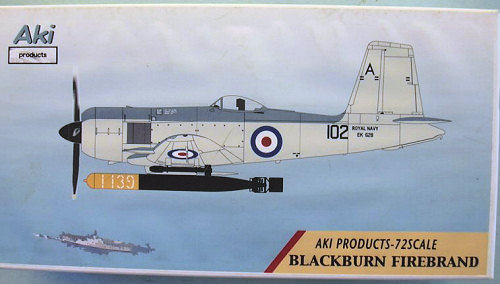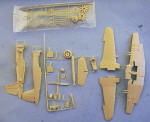
| KIT: | Aki 1/72 Firebrand TF.5 |
| KIT #: | ? |
| PRICE: | $80.00 |
| DECALS: | One option |
| REVIEWER: | Tom Cleaver |
| NOTES: | Resin kit |

| HISTORY |
The Blackburn Firebrand was the largest single-seat piston-engine aircraft operated from British aircraft carriers. The aircraft was designed in response to the requirements of Specification N.I 1/40 as the B-37. The specification called for a heavily-armed single-seat fleet defense fighter. Given the name Firebrand, the first of three prototypes, powered by a 2,305 hp Sabre III engine, flew on February 27, 1942. The second prototype carried the definitive armament of four 20-mm British Hispano cannon in the wings, with provision for one 500-lb bomb under each wing. The initial production aircraft, designated Firebrand I were used for further development. By this point, the Firebrand’s top speed of 355 mph was deemed insufficient for the fighter role. Rather than cancel the program, since there was a greater need for a modern strike aircraft than a fleet defense fighter, and given the size of the Firebrand, it was decided that this could be modified to fill the strike role. The 12 Firebrand TF Mk IIs were equipped to carry a 1,850-lb 18-inch torpedo under a widened center section, with the prototype TF Mk II flying on March 31, 1943. The production aircraft were sent to No 708 Squadron to form a trials unit in September and October 1944, where the aircraft was deemed unsuitable for carrier operation.
Due to a shortage of Sabre engines that were needed for the Typhoon and Tempest, the Firebrand was redesigned in 1943 to use a 2,400 hp Centaurus VII radial as the TF Mk III. The prototype flew on December 21, 1943. The new engine produced more torque than the Sabre, so that rudder control was insufficient on takeoff, with the result being that the TF Mk. III was found to be unsuitable for carrier operations, and work began on an improved airframe that would be better-suited for the Centaurus. The “definitive” Firebrand TF Mk IV differed from the TF Mk III in being powered by a 2,520 hp Centaurus IX and featured improved controls and the ability to carry a 2,000-lb bomb under each wing. The first TF Mk IV flew on May 17, 1945 and was followed by 102 production aircraft, entering service with the Fleet Air Arm in 1946.
The Firebrand TF Mk. IV (B-46), featured larger tail surfaces for better low-speed control, and carried dive brakes on both upper and lower wing surfaces. The final Firebrand TF Mk 5 featured minor aerodynamic improvements and 68 were produced, with 40 TF Mk IVs converted to the TF Mk 5 standard. The final production sub-type was the Firebrand TF Mk. 5A.
The prolonged development of the Firebrand meant that it did not see action in World War II, but it remained in front-line service on Royal Navy carriers until 1953. Operational experience found that even the later Firebrand was really not suited to carrier operations, the biggest problem being that the pilot sat behind the wing trailing edge and thus had to look over a very long and wide nose, which gave a particularly poor view for landing. Captain Eric Brown called it “Blackburn’s baby battleship” and considered it the worst British carrier aircraft he ever flew.
| THE KIT |
 Many modelers have been interested by Blackburn’s “baby battleship,” though only
the Mk.II has ever been produced in an injection-molded plastic kit, with one
from Valom appearing in 1/72 scale, and another being done in the same scale by
MPM several years ago. Magna Models released a 1/48 all resin Firebrand TF Mk 5
a few years ago. (and also did one in resin in 1/72 scale back about 10 years or
so. Ed)
Many modelers have been interested by Blackburn’s “baby battleship,” though only
the Mk.II has ever been produced in an injection-molded plastic kit, with one
from Valom appearing in 1/72 scale, and another being done in the same scale by
MPM several years ago. Magna Models released a 1/48 all resin Firebrand TF Mk 5
a few years ago. (and also did one in resin in 1/72 scale back about 10 years or
so. Ed)
This new kit by Aki Products in Japan
![]() is all-resin, and sets a new standard for
resin kits. The parts are as thin as an injection-molded plastic kit, with fine
delicate detail and a production design so good that parts fit is so close a
modeler will not have to use any filler such as Mr. Surfacer. The wings are in
upper and lower pieces, with the wheel wells molded in and the rocket rails
integral to the lower wing. All trailing edges are “knife sharp”. The parts are
produced on sprues, and if they were in grey resin rather than the light tan
they are, one could swear they were actually plastic and of “mainstream” quality
such as would be expected from Tamiya or Hasegawa.
is all-resin, and sets a new standard for
resin kits. The parts are as thin as an injection-molded plastic kit, with fine
delicate detail and a production design so good that parts fit is so close a
modeler will not have to use any filler such as Mr. Surfacer. The wings are in
upper and lower pieces, with the wheel wells molded in and the rocket rails
integral to the lower wing. All trailing edges are “knife sharp”. The parts are
produced on sprues, and if they were in grey resin rather than the light tan
they are, one could swear they were actually plastic and of “mainstream” quality
such as would be expected from Tamiya or Hasegawa.
 The Centaurus engine is provided in superb detail. Thin clear parts are provided
for the cowling covers, and can be posed open or closed. (You'll also note
that the landing gear are in clear. Ed) The cockpit is simple
in design but this will be effective since it is painted black overall. Underwing armament includes rockets that are molded in one piece, as well as a
torpedo. Decals are for one aircraft.
The Centaurus engine is provided in superb detail. Thin clear parts are provided
for the cowling covers, and can be posed open or closed. (You'll also note
that the landing gear are in clear. Ed) The cockpit is simple
in design but this will be effective since it is painted black overall. Underwing armament includes rockets that are molded in one piece, as well as a
torpedo. Decals are for one aircraft.
| CONCLUSIONS |
This kit sets a new standard for all-resin models and raises the bar very high indeed. I was talking to Paul Fisher, and he believes the folks at Aki Products are the ones also responsible for the Trumpeter kits of the Wyvern in 1/48 and 1/72, the 1/72 Gannet and the 1/48 Sea Hawk. Looking at this kit and those, there is a resemblance in terms of the overall detail and design quality. Production design is such that the kit is a “fall together” model that can easily be recommended to any modeler who has never built a resin kit before.
Thanks to Coopers Models for the review copy. Get yours at www.coopersmodels.com
July 2007
If you would like your product reviewed fairly and quickly by a site that has nearly 400,000 visitors a month, please contact me or see other details in the Note to Contributors.